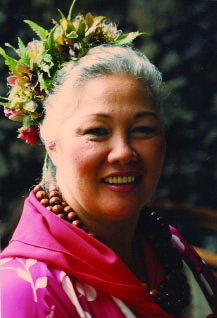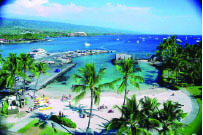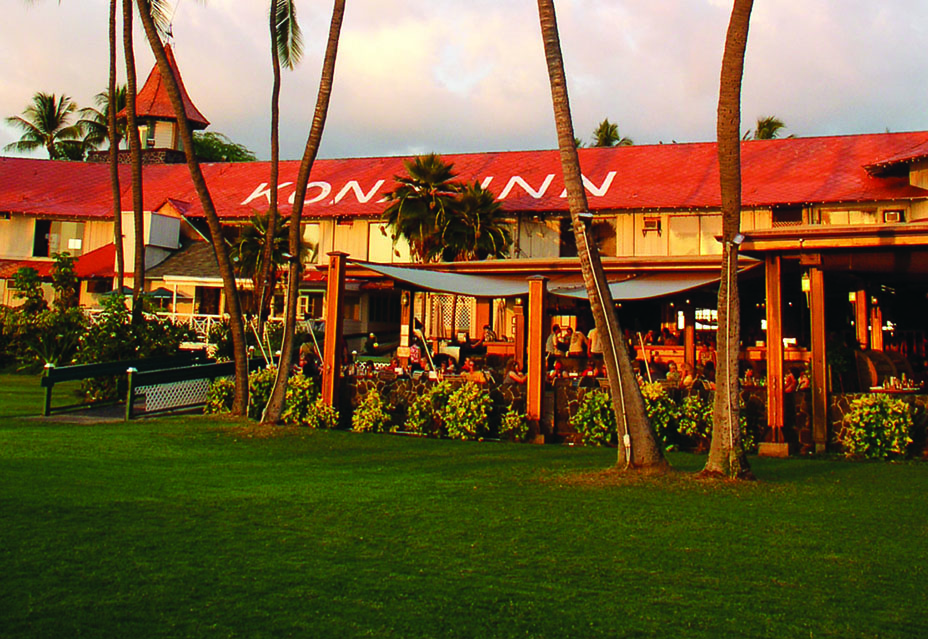
This Kupuna Radiates Beauty, from the Inside
Hawaiian Studies Educator & Kumu Hula Ulalia Berman
By Ann C. Peterson

One look at her and you understand the meaning of “Aloha”— she is always dressed in Hawaiian patterns, wearing a lei—made from any number of things…flowers, nuts, seeds, shells… and often with flowers in her upswept, pure-white hair. Love and beauty radiate from her sparkling hazel eyes – somehow incongruent. Her ready smile is there for everyone (well, except perhaps misbehaving students). This woman draws you in and, if you’ve never met her, the rolodex in your mind starts flipping; looking for the context—who is this woman?— because instinctively, even if you’ve never met Kumu Hula Ulalia Ka‘ai Berman, you want to get a hug.
Why is it that hugging Ulalia—even if you don’t know her—seems like the most natural thing in the world? Why does this Kona teacher of Hawaiian studies, mentor to other teachers, musician and cultural representative, who so obviously embraces the very essence of Hawai‘i, have hazel eyes? And, how in the world can someone look this good in anything from a holoku to a pareo? Well to understand, let’s step back a few decades to 1940s O‘ahu.
Ulalia was born in the luscious ahupua‘a of Nu’uanu Valley, on O‘ahu in the ‘ili of Pu‘unui, “which we always called Laukalo,” adds Ulalia explaning that lau means ‘leaf’ and kalo means ‘taro’; the perfect name for an area that was once a central growing region. Remnants of the terraced field system were still visible during Ulalia’s childhood, and the area was rife with myths and legends.
Rumors of Pele sightings circulated, a certain rock was whispered to bear the handprints of menehune, and no one would carry pork over the pali— not wanting to provoke any mischief from the famous pig god, Kamapua‘a. Ulalia remembers heading over the pali with Papa Sam, her grandfather, and her six brothers and sisters in his Chevy Coupe— with her stuffed into the rumble seat with four of them—no pork!
Kids growing up in Nu‘uanu played in the forest and streams that were their backyard and they learned to swim in the streams and ponds before going into the ocean. There were plenty of low-hanging guavas to pick for juicing. The land seemed wild, but the close-knit community took care of the land, watched over its keiki, and folks were well-mannered and respectful.
As Ulalia and I sat in a coffee house and talked about her life, I saw a measure of how her background shaped her. She tapped on the window to let a fellow outside know that he had dropped his keys; she grabbed both of my hands just as I reached for the blueberry scone, bowed her head and began a passionate prayer blessing the food before us (I loved it); several people come up to her to talk story—her Aloha showing brightly!
Ulalia’s father, Ernest Kaleihoku Ka‘ai, Jr. was a musician and toured China, Japan, New Zealand, and the mainland, playing with his father and brother. When in town he played in Waikiki and other local gigs; and often played backup for visiting musicians. “Dad could play any instrument,” said Ulalia. “Once he was in Bobby’s music store on Hotel Street and an African-American sailor came in with an unknown instrument that had been in his family a long time. Dad opened the box, and instantly knew its African name and how to play it.”
Her mother, Josephine Ulalia Ikuwa Ka‘ai was a nurse and was in great demand with her expert medical skills, her caring way, and her attention to details. She lived to be 98 years old with over 100 descendants honoring her life. Ulalia’s father died was she was ten, and with her mother working to support the family, Ulalia took on a lot of housekeeping duties. She loved cooking and caring for the younger siblings. “Mom was an okay cook, but my Dad had always done the cooking—he had a flair with spices that he taught me,” she laughs.

Ulalia’s father had some Caucasian blood in him—yes, this is where her shining hazel eyes come from, along with other colorful Western influences on her family. A couple of her brothers had red hair, and the siblings’ skin tone varied from lily white to luscious tan. The variety of skin tones accepted in Hawai‘i was seen in a different light on a trip to Florida to visit her grandfather in 1948. “We flew to California, then took trains and buses all the way across the mainland. While in the South, my mother was told to go to the back of the bus. Of course she refused, ‘I’m Hawaiian, and I’m staying right here,’ she announced to all,” Ulalia said, affecting her mother’s stance and tone.
Of course they met lovely people along the way as well, “We were having dinner in a restaurant and when my father went to pay, he was told that the bill was already settled.” Ulalia explains that the town’s doctor was so impressed by the manners of the Ka‘ai family, especially in comparison to his own lack of control over his own two boys, that he wanted to pay tribute to them.
Ulalia began taking hula lessons even before she could remember. One of her feet was shorter than the other, and one of her aunties suggested that she take hula lessons when she started to walk to help with her coordination. “I don’t really remember those early lessons,” she said. When she was six or seven, she started with Halau Hula o Makai, with Kumu Hula Maiki Aiu Lake, a halau that she stayed with for 40 years.
In the 1970s, Ulalia performed at the Merrie Monarch, “Just once to try it. I’m really not a competitive person,” she says, while in total admiration of those who do dedicate themselves to Hawaii’s traditional culture at this high level; particularly (and you can’t blame her) her granddaughter, Surreney Ann Ho‘ola‘ikahiluonalani, who dances with the Lim family’s grand-prize-winning halau, Na Lei Kaholoku. Her three granddaughters, Lia Ann Ki‘ohu‘ohuleianu‘enu‘e, Sheldan Nanea, and Jade Josephine Hauoli, also dance hula, and her son, Robert Lono Ikuwa, published a children’s book in Hawaiian, Tutu Hamana: The Shaka Sign Story. Of course she is proud of all her children, Mike, Analu, Ho‘ola‘i, and Lono, mentioned above, and her nine grandchildren. Ulalia married Kona Berman in 1966, and they moved to North kona the same year. She lives in Kaloko mauka, and this is also the location of her school of dance.
These days, Ulalia is busier than ever, “I never imagined I’d be where I am today,” she said explaining that she’d just earned a Bachelor of Arts from UH. Earning a BA may be enough for most folks in their sixties, but Ulalia, “Can’t stop working—glad I’m busy.” No problem there, she is the Kumu Hula of Ulalaia’s School of Hawaiian Dance; performs weddings, blessings, and memorial services; sings in the choir at St. Michael’s Catholic Church; demonstrates how to make traditional instruments at cultural events; and is a member of Ahahui Ka‘ahumanu, a group of 125 woman who formed in 1913 to honor the legacy of Queen Ka‘ahumanu.
Ulalia tried to retire from the Department of Education after teaching in the Kupuna Hawaiian Studies program for 25 years, but was instead put in charge of Project Kahua, a collaboration between the DOE, Kamehameha Schools, and several other organizations to mentor new teachers. Ulalia coaches eight mentors who in turn support 31 teachers in 23 schools around the island.
Ulalia started teaching at Hualalai Academy two years ago where she is the Kumu for Hawaiian Studies. Foremost on her plate is the school’s May Day celebration. “We’ve picked an ocean theme, and each grade will do a dance about the ocean before the Royal Court,” she explains. She has a large production before her; teaching not only the dance, but also the meaning behind the songs to each class; determining the appropriate attire and accessories; teaching each student how to make their instrument or string their lei; and so much more. But she is such a pro that planning for this event along with the other things on her plate is second nature.
What is she doing this weekend? “Going camping!” Yet, she will still have to leave the campsite a couple times to meet some obligations. This woman is not only gracious, and full of Aloha, she’s tireless! ❖


